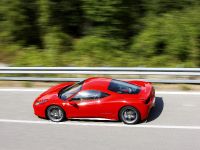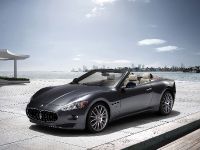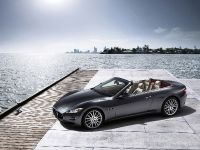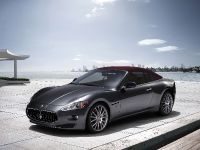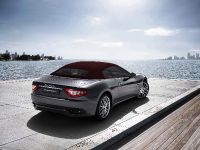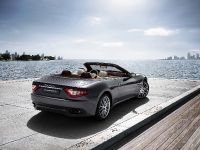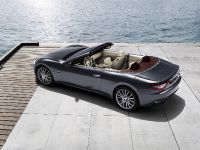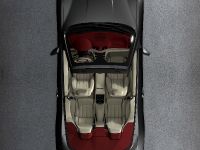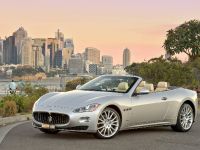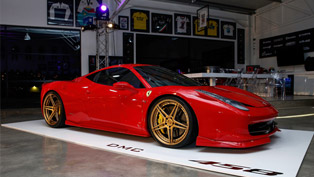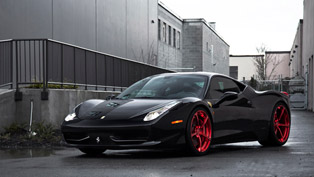Pininfarina design - link between the biggest
Pininfarina design comes into its own at the Frankfurt Motor Show, thanks to the novelties presented by two prestigious customers, Ferrari and Maserati. The Show hosts the world debut of the Ferrari 458 Italia, a new generation rear-engined berlinetta, and the Maserati GranCabrio, the first four-seater cabriolet in Maserati history.
The new Ferrari 458 Italia marks a generation leap for 8-cylinder mid-rear engined cars with a strong racing temperament from the Maranello Company. The new car is a synthesis of technological innovation, creativeness, style and passion, one that is also representative of Italy, a fact that Ferrari pays tribute to with its decision to add Italia to the car's name after the traditional reference to its capacity and number of cylinders.
The Ferrari 458 Italia is a two-seater Berlinetta that is completely new in every way: the power pack, design, aerodynamics, handling, instrumentation and man-machine interface, to name just a few. The design, created by Pininfarina, hinges on a compact, streamlined shape, which expresses the concepts of essentiality, efficiency and lightness that inspired the project. Like all Ferraris, the styling is closely linked to aerodynamic efficiency, which also generates a vertical load of 140 kg at 200 km/h on this car. The front end has a single vent, with lateral air intakes, and the profile sections designed to direct the air towards the engine radiators and the new flat bottom. The 458 Italia also has small fins positioned in front of the radiators, which generate vertical load and deform aero-elastically as the speed increases to reduce the radiator intake section and thus drag.
"The 458 Italia marks a new milestone in the historical collaboration between Ferrari and Pininfarina," commented Paolo Pininfarina, Chairman of the Group. "The stylistic definition of the model, coordinated by the Ferrari Styling Department team, examined every detail of even the smallest part, focusing on a number of key concepts: simplicity, essentiality, technology, total aerodynamics, efficiency and lightness. The result is a car that has extremely innovative styling but yet retains the main Ferrari characteristics, like the visible engine typical of sportier 8-cylinder models."
"The design of an 8-cylinder berlinetta, a model that has always embodied all Ferrari's intrinsic values with extraordinary sportiness and elegance, demanded an unusual approach, that took into consideration the sweeping changes taking place around the world," added Lowie Vermeersch, Pininfarina Design Director. "The stylistic research thus evolved through a new ethical conscience on the part of the designer and new design drivers, such as lower consumption and reduced emissions. In architectural terms, this philosophy has translated into lower weights and a smaller front section, which brought benefits in terms of aerodynamics. Where styling is concerned, a great deal of work was done on the optical perception of a compact but streamlined mass obtained by "streamlining" the volumes and the tension applied to the surfaces."
For lovers of Maserati convertibles, Frankfurt also marks the world debut of a new cabriolet designed by Pininfarina, the Maserati GranCabrio. This car completes the Maserati range, which now contains three families of models - saloon, coupe, cabriolet - all designed by Pininfarina: the Quattroporte, GranTurismo and GranCabrio.
The GranCabrio is a Maserati in the purest sense of the term: from the Pininfarina style to the spacious interior, the craftsmanship of each detail, and the enjoyable drive and performance. The GranCabrio upholds the Maserati convertible tradition, opening a new chapter: no four-seater open-air model has ever left the plants in Viale Ciro Menotti 322. Powered by a 4.7-litre V8 engine that delivers 440 bhp, the GranCabrio has the longest wheelbase of any cabriolet in its market segment. To underline the link with Maserati tradition, the roof is exclusively canvas.
The Frankfurt Motor Show hosts the presentation of the restyled version of the Volvo C70. The styling of the Swedish coupé-cabriolet has been modernised at the front and the rear, sustained by the characteristics that made the previous version a success: the hardtop system that folds into three parts simply by pressing a button in the car, transforming it into an open sports car or an elegant coupe, with four proper seats and technology that makes it one of the safest convertibles in the world. Even the new C70 will be built by Pininfarina Sverige, the joint venture between Pininfarina S.p.A. (60%) and the Volvo Car Corporation (40%), which was established in 2003 in Uddevalla, Sweden.







